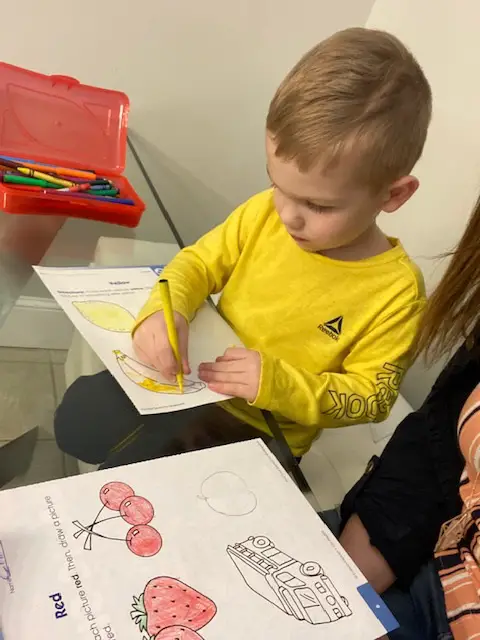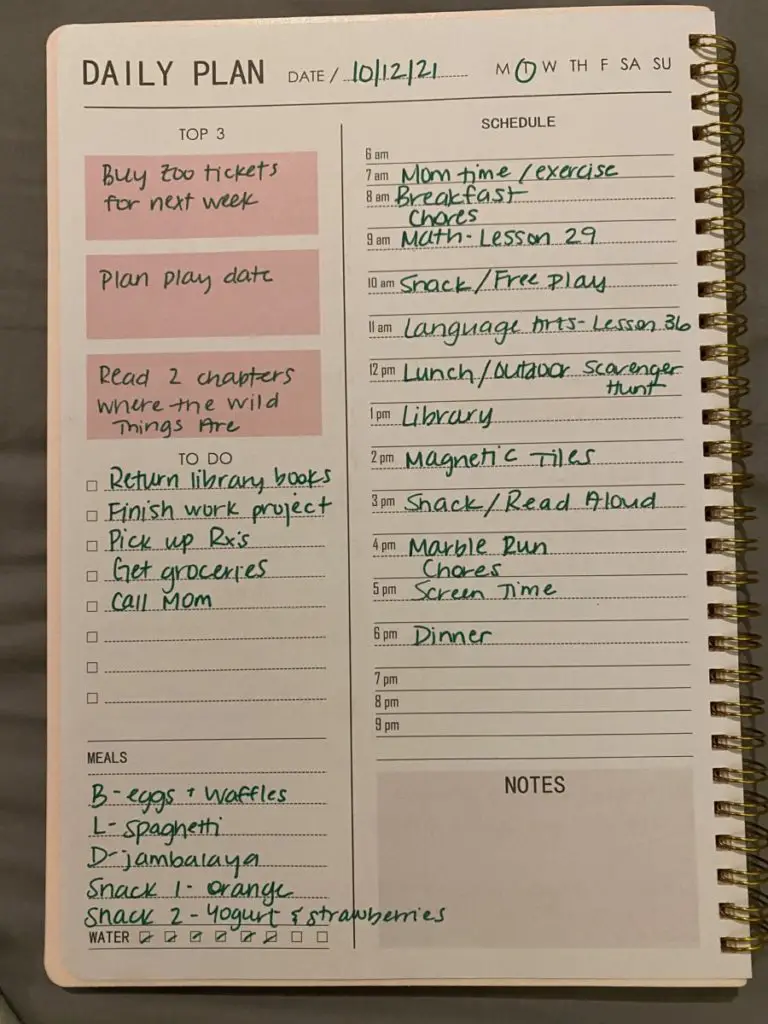Do you feel overwhelmed when you think about creating a homeschool schedule? You’re not alone!
It can be daunting to figure out how to plan your days and weeks. But don’t worry, I’m here to help!
In this post, I’ll walk you through 12 easy steps for creating a homeschool schedule that works for your family. So read on and get started!

1. Determine Your Homeschooling Style
Determining your unique homeschool style is vital to the success of homeschooling your children. The reason this is so important is that it determines which type of curriculum to purchase or whether you will purchase a curriculum at all!
The Call of the Wild and Free: Reclaiming the Wonder in Your Child’s Education, A New Way to Homeschool by Ainsley Arment is an excellent book to read to gain information on homeschooling in general, but also, on the different types of homeschooling styles.
Here are the main homeschool styles:
Traditional – This structured teaching style is the closest to the traditional school approach and is essentially school-at-home. It is good for those that are new to homeschooling, especially when they haven’t learned their style yet.
Charlotte Mason -This style does not use textbooks, but rather uses rich literature, and asks children to narrate what they have learned.
Unit Studies – This homeschool style takes a theme and combines all subjects into one. For example, if you are learning about horses, you might measure a horse, write a story about a horse, and research the history of horses.
Montessori – This style takes a child-led approach to learning, catering to a child’s interests. The environment typically encourages play and exploration.
Classical – This style teaches children how to think for themselves by using grammar, logic, and rhetoric.
Unschooling – This type of education is unstructured, child-led, and very flexible. Unschoolers typically learn through experience outside of a textbook.
Eclectic – Eceletic homeschoolers take a mixture of the different learning styles to make them their own. This might look like textbook learning for math and language arts, park days to explore nature for science, and watching a historical documentary and narrating it back to the parent.

2. Determine Your Child’s Learning Style
There are 3 main learning styles for children:
Kinesthetic – This type of learner wants to do it themselves and learns best by moving. A good example of a kinesthetic learner is a child who has trouble sitting still and enjoys playing physical games to learn.
Auditory – This type of learner learns best by hearing it. An example of an auditory learner is a child who enjoys listening to songs to learn phonics.
Visual – This type of learner learns best by seeing it. A good example of a visual learner is watching a video to learn how to memorize multiplication tables.
Every child is unique, and there are ways to adapt to their learning style to help them achieve success in homeschooling.
Discover Your Child’s Learning Style: Personalized Learning for Student Success by Mariaemma Willis, M.S. and Victoria Kindle Hodson, M.A. is a great resource to understanding your child’s strengths and weaknesses before starting to homeschool.
3. Determine if You Want to Do Year-Round Homeschooling
It’s important to decide if you want to do school year-round before deciding on your daily schedule. The reason for this is that your school days can be shorter and you can even do fewer days each week if you plan to go year-round.
We’ve decided to do school year-round for many reasons:
Structure – We found it difficult for our son to get back into the swing of things at the beginning of the school year. He thrives on routine and we don’t have to break any bad habits when the new year starts.
Shorter school days – Since we do school year-round, we can shorten his school days. It is much easier for him if we do shorter days spread out over the year.
Graduate early – Our hope is that my son will be able to graduate early and focus on college or building a business in his teenage years.
There are many different reasons for different families, but these were ours. We do plan to take 6 weeks off at the end of the year (Thanksgiving-New Year.)

4. Determine How Much Time You Want to Homeschool Daily
Many parents that are considering homeschooling their children are intimidated by how long traditional school days are and don’t consider homeschooling as an option because they don’t have 7 hours each day to teach their children.
Neither do I!
Homeschooling takes significantly less time than public schooling! Most homeschoolers are able to finish their schoolwork within 30 minutes-4 hours.
Here is an article detailing how long homeschooling takes on average per grade level.
Once you figure out the amount of homeschooling that your child will need, assess how much time you have in your day to homeschool. Hopefully, you will have enough time in your day to homeschool. If not, get creative.
Do you have plenty of time 3 days a week, but not on 2? That’s the beauty of homeschooling. Maybe you only homeschool Monday, Wednesday, and Friday!
Do you have plenty of time in the evenings, but not in the morning. That’s fine too!
5. Decide How Many Days/Week You Want to Homeschool
Let’s say that you work part-time, and don’t have time to homeschool each day. Do the math and see how much time you need to homeschool those days.
We typically homeschool 4 days a week. I’ve found that to be the best balance for our son. He gets a day off, and we save that day for life lessons, field trips, doctor’s appointments, and practical skills.

6. Determine Which Curriculum is the Best Fit
Now you are ready to dive into curriculums. Many parents new to homeschooling find curriculums to be the overwhelming part.
It doesn’t have to be.
Cathy Duffy’s 102 Top Picks for Homeschool Curriculum is essential (in my opinion) to choosing the correct curriculum for your child.
She uses several self-assessments to help parents combine their child’s learning style with the parent’s teaching style in order to choose a curriculum that would be a good fit.
This book can save you hundreds of dollars spent on potentially purchasing the wrong material for your child, so I urge you to read her book before making any purchases.
Do your research and set yourself up for success.

7. Set Goals for the School Year
Instead of making things super structured at the beginning of the school year, try setting goals instead.
For example, instead of cracking down on lesson plans, write a list of goals you hope to achieve this school year.
Do you want your child to be able to memorize a certain number of Bible verses, be able to identify all letters and their sounds, or be able to recite the Gettysburg Address?
Be specific and use these goals as a starting point to keep you focused on how much your children are learning throughout the year.
8. Don’t Make a Schedule at First
At first, it’s tempting to make a structured schedule, laminate it, and post it to the fridge.
The problem will making an official schedule when you’re just beginning is that it can leave you feeling like you are falling behind on your schedule and incites anxiety to rush through to stay on track.
I’d recommend starting without a schedule for a few weeks. See what happens naturally and take notes on what is going well and what could go better.
By taking a more relaxed approach, you’ll be setting yourself and your homeschoolers up for success.
Have a general goal in mind. For me, it is having schoolwork completed by 11:30 AM. As long as that is accomplished, we feel like we’ve had a great day.

9. Establish a Routine
Once you start naturally, you’ll begin to develop a routine. Reference your notes. What is going well? What could use some more structure or planning?
Maybe your best days were when you did math first. Maybe you’ve noticed that the afternoons you read aloud to your children, they settled down and played better together afterward.
Give yourself some time to thoughtfully make the routine. I hesitate to call it a schedule because it doesn’t have to be super strict and structured to work well. I’d actually argue that our more productive days are when we take a much more relaxed approach to learning.

10. Build in Breaks, Field Trips, and Outdoor Playtime
When building your homeschooling schedule/routine, don’t forget to consider the attention span of your child based on their age. Make sure to give breaks and outdoor playtime to give kids plenty of downtime.
Attention spans are typically 2-3 minutes per age of their year.
| Age | Average Attention Span |
| 4 | 8-12 minutes |
| 5 | 10-15 minutes |
| 6 | 12-18 minutes |
| 7 | 14-21 minutes |
| 8 | 16-24 minutes |
| 9 | 18-27 minutes |
| 10 | 20-30 minutes |
| 11 | 22-33 minutes |
| 12 | 24-36 minutes |
| 13 | 26-39 minutes |
| 14 | 28-42 minutes |
| 15 | 30-45 minutes |
| 16 | 32-48 minutes |
| 17 | 34-51 minutes |
| 18 | 36-54 minutes |
By doing schoolwork in short bursts, you will be able to keep children engaged in their schoolwork which means more learning and less frustration.
Don’t expect too much from your children before they are developmentally ready to give you your desired results. They’ll get there when they’re ready.

11. Create Your Schedule
Now that you have all the information needed to create an effective schedule, go ahead and create it. I love this Daily Planner from KAICN.
The main reason I’ve found this planner so effective is that I can change it on a daily basis. I usually make my schedule in the evening for the next day.
We have a similar routine every day, but some days we focus more on one subject than another or plan different activities to supplement our schoolwork.
12. Make Adjustments as Needed
Inevitably, there need to be adjustments made along the way. By creating a daily plan each evening for the following day, you can easily make changes to your daily schedule.
Conclusion
Now that we’ve walked you through the 12 easy steps to creating your homeschool schedule, it’s time for you to get creative! Be sure to add in your own personal touches, and don’t be afraid to make adjustments as needed.
As with anything else in life, your first attempt at scheduling may not be perfect. Be prepared to make adjustments as needed and don’t forget to have fun. The most important thing is that you are both learning and enjoying this new adventure together.
One last thing, be sure to prioritize the parent-child relationship over the teacher-student relationship. Above all else, your child needs their parent, not a full-time teacher.
Please add your own tips for creating a successful homeschooling schedule in the comments below!

